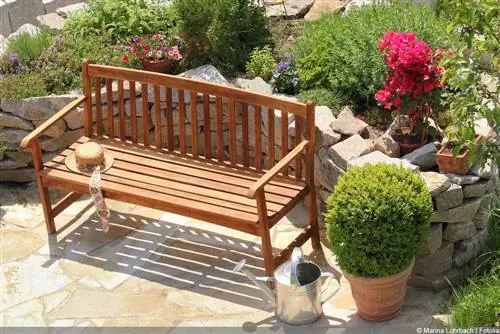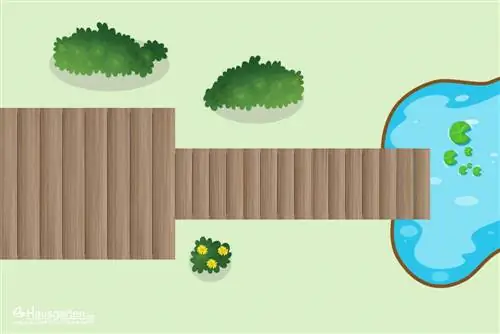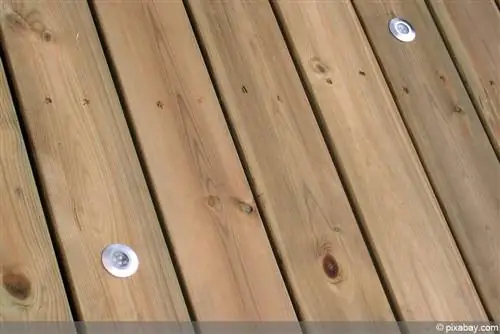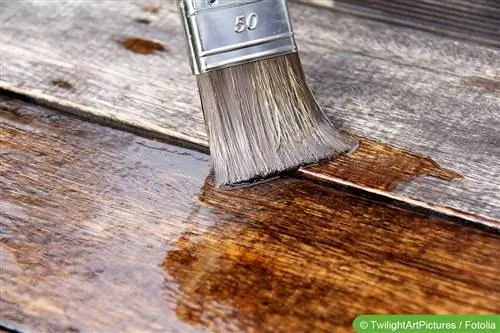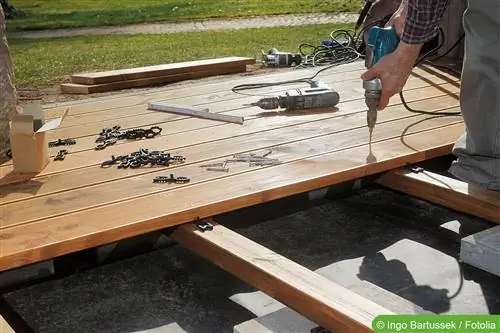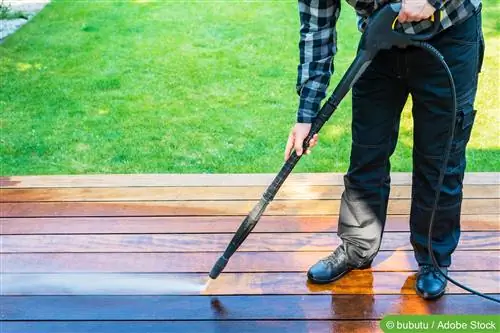- Author admin [email protected].
- Public 2023-12-17 03:39.
- Last modified 2025-01-24 12:45.
Numerous types of wood from all over the world are available in Europe. But the large selection does not make the decision to purchase garden bench wooden slats any easier. Some are not suitable at all, others are more sensitive and others have special properties. Ultimately, however, it depends on individual requirements. The DIY guide explains which wood is suitable and what properties can be expected.
Individual requirements
If you would like to equip your garden bench with new wooden slats, you should answer a few questions in advance in order to find the suitable type of wood specifically for your wooden bench. These questions provide information about what conditions the wood will be exposed to and what individual requirements it should meet.
The questions are:
- Is the garden bench covered or not protected from the weather?
- Does the garden bench stay outdoors all year round or does it move into dry winter quarters?
- Do you prefer a particular color or grain?
- What should the maximum care requirement be?
- Is the bank heavily and heavily used?
- Should the price be cheap or mediocre or should the wooden slats cost something?
- Do you only want a type of wood from the region, somewhere from Germany or can it come from overseas?
Acacia
The real acacia (Acacieae) is native to the tropics and subtropics. It is often imported from Australia, Asia and Africa. The acacia should not be confused with the one that is grown in Europe and is available as a false acacia called common or false black locust (Robinia pseudoacacia). This is mostly imported from Hungary. The wood of real acacia is extremely robust and 1.7 times stronger than oak, but significantly more flexible. This has the advantage that the wood warps only slightly and hardly any cracks occur. It is very resistant to fungi and pests. With a lifespan of up to 40 years (untreated acacia wood), it is one of the most durable types of wood. For your garden bench, wooden slats made from acacia are an excellent choice for any weather and any season. In terms of price, it is in the upper midfield and is cheaper than teak.
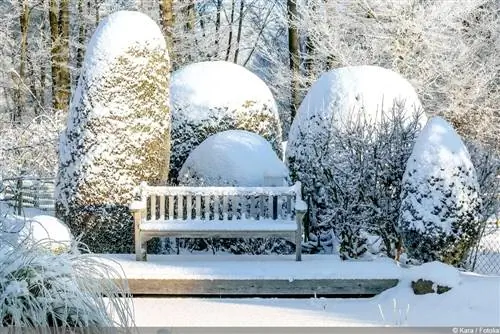
Bankirai
Bankirai is a type of wood that is primarily used as decking. As wooden slats they are more difficult to obtain. This wood, which comes from Indonesia, can be recognized by its dark reddish color and mostly longitudinal grooves or grains on the surface. In many cases it darkens to dark olive. It impresses with its very high resistance to weather and rot. This actually makes it an ideal type of wood for your garden bench. However, the heavy wood only has moderate strength properties. In addition, it reacts upon contact with ferrous metals and forms gray-blue discolorations. It has a tendency to crack and slightly deform. The wood is still not cheap. Depending on the provider, it settles in the middle price range.
Douglas fir
As a cheap alternative to teak, oak, acacia and eucalyptus, you can use Douglas fir wooden slats for your garden bench. This type of wood has its origins in North America. However, the cultivation of Douglas fir is now widespread. The wood is a softwood that has the properties of hardness, dryness and easy to work with. The heartwood is yellowish-brown to reddish-yellow. Depending on the light intensity, it darkens to a red-brown color. It looks very decorative due to its strong stripes and flakes, but it is still not widely used in garden furniture production. Regular impregnation is required. However, it is not as weather-resistant as teak or acacia wood in the long term. That's why this type of wood is recommended for garden benches that are under a roof and are moving to a frost-free, dry winter quarters.
Oak
Oak wood still has a good reputation today. This is due not least to the high durability and hardness that it has. The latter in particular makes it a suitable wood for garden benches. However, compared to the wooden slats made of acacia, teak and eucalyptus, cracks can occur if the wood is dry for too long. However, these do not affect the quality or the statics. If it gets wet again, the cracks will tighten again. Wooden slats made of solid wood are almost indestructible and made to last. A special oil impregnation strengthens the elegant grain and at the same time protects the surface from external influences. It also requires regular treatment with care products.
Tip:
Oak slats are not cheap, but they are generally cheaper than teak.
Eucalyptus
Eucalyptus wood offers more than 600 species. It comes from Australia and is now also cultivated in the middle area. Eucalyptus is very popular in garden furniture production. The tree, which belongs to the myrtle family, impresses with its extremely high degree of hardness. The formation of cracks is almost impossible. The eucalyptus wood has a light reddish to dark brown color and an interesting grain. It is quite resistant to pests and weather of all seasons.
However, it tends to become brittle. Appropriate care is required to keep the wood supple. Overwintering outdoors can cause it to become brittle, so it is better for your garden bench to spend the winter frost-free. Depending on the type and quality, the price is significantly lower than the wooden slats made of acacia or teak.
Pine
Probably the cheapest option is to get wooden slats made of pine. It impresses with its good processing properties and can be seen in affordable garden furniture. New pine wood has a yellowish to slightly reddish color. Over time it sometimes darkens significantly. It is slightly more durable than spruce wood. It is quite fatty and resinous and can show many knots. This has the disadvantage for your garden bench that rough wood can have a negative impact on seating comfort. If it is not impregnated regularly at relatively short intervals, moisture will penetrate, which is why it is less suitable for an outdoor garden bench. Rot is not uncommon, nor is a short lifespan. In addition, it is a softwood that only achieves stability with a correspondingly narrow substructure.
Larch
The heartwood of the larch native here appears reddish-brown and darkens over time. A yellowish-white sapwood provides a decorative contrast. It has a low risk of rotting due to a relatively high resin content. This makes it, among other things, a long-lasting type of wood that is also weather-resistant and therefore suitable for outdoor garden benches. For very long garden benches, there should be cross braces at even intervals under the wooden slats. Although larch is a hard material, it tends to break if the dimensions are long and the load is too high. Regular care with wood products is recommended to keep it beautiful in the long term.
Tip:
In terms of price, wooden slats made of larch are just slightly higher than those made of pine.
Tip:
Robinie
Robinia wood slats have less hardness and strength than real acacia wood slats, but more than oak slats. A long durability and a very high level of weather resistance combined with low maintenance requirements due to the lack of impregnation make wooden slats made of Robine a slightly cheaper alternative to real acacia.
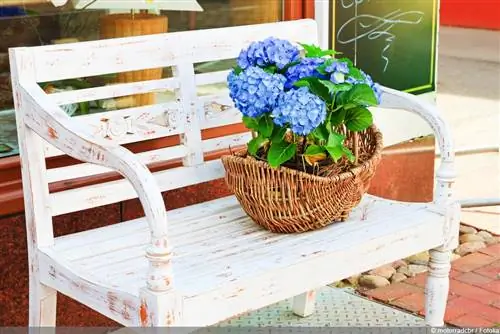
Sipo
Sipo is a type of wood that comes from a deciduous tree in Africa and is not yet widespread in these areas. It is considered to be weather-resistant and has a high level of hardness. As we age, it continually becomes darker. However, the strength is significantly lower than that of wooden slats made of acacia, oak or teak and may break more quickly than you would like. This type of wood is definitely suitable for a garden bench that is purely decorative or intended for children. For heavier people who will sit on the garden bench, you should choose a firmer type of wood.
Teak
A real classic among wooden garden furniture is teak. This is a hardwood that is characterized by very high weather resistance and visual elegance. In addition, this type of wood is extremely resistant to pests, has a long life expectancy even with heavy use and does not require much care. Teak comes from Southeast Asia and is obtained from the teak tree (Tectona grandis). This belongs to the mint family (Lamiaceae). Teak wooden slats are one of the best options for your garden bench, especially if it is outdoors all year round and is exposed to sun, rain, snow, heat and cold.
Tip:
In terms of price, it is in the upper segment compared to other types of wood.
Social and ecological compatibility
In addition to choosing the ideal type of wood for the wooden slats of your garden bench, social and ecological aspects should not be ignored.
You can recognize corresponding products, for example, by various eco and environmental seals, such as:
- FSC(R) Fairtrade certification
- Blue Angel
- PEFC

